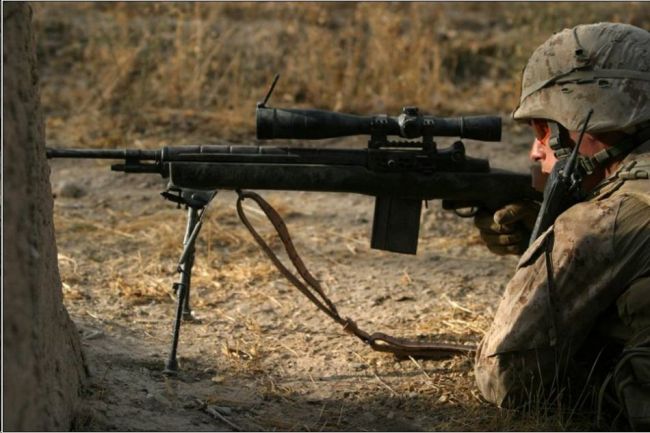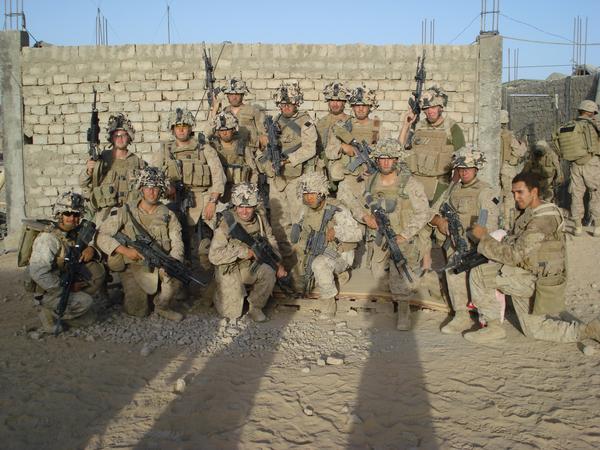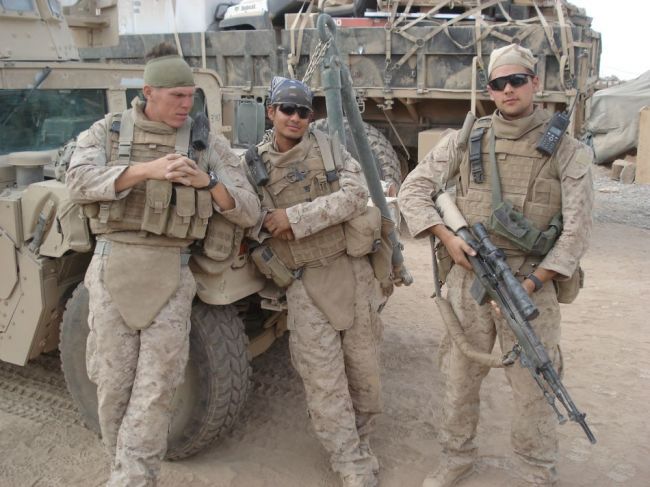You are using an out of date browser. It may not display this or other websites correctly.
You should upgrade or use an alternative browser.
You should upgrade or use an alternative browser.
7.62x51: Two Marines’ Perspectives
- Thread starter rjinga
- Start date
bbqncigars
New member
What 44AMP said. If I were on my own, I'd treat every round as if I were shooting a muzzleloader. 'Is this shot really necessary? I'll add that it is always nice to hear from those who have BTDT.
I've made this comment before. The 5.56 was so miserably ineffective in combat that after the Russians saw how it performed in Vietnam they promptly came out with their own version of it and abandoned their .30 cal round.So, many of us feel that the decision to adopt the 5.56 was driven by cost considerations (acquisition, ammo, resupply, and training) at the expense of combat effectiveness. Your opinion many varry.
It's hard to view that fact as anything other than a very powerful endorsement combat effectiveness of the round.
if the bad guys get behind any type of cover, you may wish some one had a 7.62x51. i worked over several junked car(regular cars) with a few friends with .30 carbine-.223-7.62x39- 7.62x51 and 3006, shooting AP ammo in all five rifles and the first three didn,t fair to well, but the last two did good. the only part of the car that would have saved you from the last two was behind the engine. by the way i own all five calibers in military dress and carried both the m-14 and m-16 in vn. eastbank.
stagpanther
New member
Of course not.Now, I’m really not trying to stir up the never-ending “this round is a better choice than that round because of blab, blab, and blab” debate.
I have no military/LEO experience at all. But
The "range talk" that I hear from those who have returned from combat--are more than likely comparing the basic 7.62 x 39 that they encountered to the 5.56; not the 7.62 x 51 NATO cartridge.
I have built 4 AR10 type weapons and by the time you outfit them with the necessary components to really reach out effectively and engage with more powerful cartridges--you're talking the better part of 12 to 15 lbs locked and loaded. To reduce that weight means either reduce effectiveness or make it a sniper-type bolt action weapon as far as I know. Having one or two of these around as a squad-designated support weapon--makes perfect sense (though I wouldn't be the first in line to volunteer to hump the thing) but as a main squad rifle weapon, at least where the level of technology is at present--makes no sense at all to this armchair quarterback.
Last edited:
those who have returned from combat--are more than likely comparing the basic 7.62 x 39 that they encountered to the 5.56; not the 7.62 x 51 NATO cartridge.
Possibly. But there are THREE 7.62mm rounds common in theater, ours (x51mm NATO) and the two former Soviet rounds x39, and x54R.
I think it highly likely that our troops have at least encountered the 7.62NATO, since it is our standard medium machinegun round...and our infantry does have a few of them..
Context should make it pretty clear if they are talking about 7.62 effect on the enemy, then its probably our round they are talking about.
Mike Irwin
Staff
"In Cuba in 1898 nobody complained about the stopping power or accuracy of the 45-70, it was that big cloud of white smoke....."
There were recorded instances in the Philippines of the .45-70 round FAILING to stop charging Moro tribesmen.
In fact, about the only truly effective weapon for that purpose at the disposal of US troops was the Winchester Model 1897 shotgun.
There were recorded instances in the Philippines of the .45-70 round FAILING to stop charging Moro tribesmen.
In fact, about the only truly effective weapon for that purpose at the disposal of US troops was the Winchester Model 1897 shotgun.
Mike Irwin
Staff
"I'm not saying the 5.56 is "inadequate" but it does have it's limitations."
And so does the 7.62x51.
The simple, incontrovertible fact is...
No one weapons system will be the perfect choice for every possible combat scenario.
The US military has invested billions of dollars in the mythical quest for The One Grand Unified Weapon System, but everything they have tried has been a failure.
Sure, those entrants have been absolutely great at some things, but at other things they're a dismal failure.
Yet that hasn't stopped the military's search for the weapons system that will be lightweight, rugged, essentially foolproof mechanically, require little care and maintenance, is capable of being used in roles ranging from submachine gun to sniper rifle to squad automatic weapon, fire a lightweight cartridge, fire a cartridge with very little felt recoil, fire a cartridge that delivers devastating ballistic impact from the muzzle to 1000+ meters.
The list goes on and on, with each "absolute must have" requirement of The One Grand Unified Weapon System being more and more mutually exclusive, impractical, and completely impossible to achieve.
There's a damned good reason why current US forces are employing a hybrid armaments arrangement at the company level.
And so does the 7.62x51.
The simple, incontrovertible fact is...
No one weapons system will be the perfect choice for every possible combat scenario.
The US military has invested billions of dollars in the mythical quest for The One Grand Unified Weapon System, but everything they have tried has been a failure.
Sure, those entrants have been absolutely great at some things, but at other things they're a dismal failure.
Yet that hasn't stopped the military's search for the weapons system that will be lightweight, rugged, essentially foolproof mechanically, require little care and maintenance, is capable of being used in roles ranging from submachine gun to sniper rifle to squad automatic weapon, fire a lightweight cartridge, fire a cartridge with very little felt recoil, fire a cartridge that delivers devastating ballistic impact from the muzzle to 1000+ meters.
The list goes on and on, with each "absolute must have" requirement of The One Grand Unified Weapon System being more and more mutually exclusive, impractical, and completely impossible to achieve.
There's a damned good reason why current US forces are employing a hybrid armaments arrangement at the company level.
Mike Irwin
Staff
"Possibly. But there are THREE 7.62mm rounds common in theater, ours (x51mm NATO) and the two former Soviet rounds x39, and x54R."
US troops have also encountered another 7.62 round fairly regularly in Afghanistan...
The .303 British. It is still heavily used in many of the tribal areas.
US troops have also encountered another 7.62 round fairly regularly in Afghanistan...
The .303 British. It is still heavily used in many of the tribal areas.
I've discussed the one rifle fits all issue with my son many times and there is a reason the USMC looks at the larger picture in terms of how to approach a fight.
Here is part of the story:
http://www.washingtonpost.com/wp-dyn/content/article/2009/06/12/AR2009061202123.html
One of his squad had a DMR... M14 most had M16A4 or M4 and 4ea. M249.



It is a group effort to achieve results... the 5.56 and 7.62 are a part of the solution, but so are the individual and group's ability to coordinate ammo resupply, .50 cal snipers, vehicles...
1000+ in, 170+ wounded, 20KIA
Now Zad after... http://www.washingtonpost.com/wp-dyn/content/article/2010/02/18/AR2010021803180.html
I still hear from Ivan's mother... no rifle would have helped him.
Sorry guys... went sideways for a moment there.
Here is part of the story:
http://www.washingtonpost.com/wp-dyn/content/article/2009/06/12/AR2009061202123.html
One of his squad had a DMR... M14 most had M16A4 or M4 and 4ea. M249.



It is a group effort to achieve results... the 5.56 and 7.62 are a part of the solution, but so are the individual and group's ability to coordinate ammo resupply, .50 cal snipers, vehicles...
1000+ in, 170+ wounded, 20KIA
Now Zad after... http://www.washingtonpost.com/wp-dyn/content/article/2010/02/18/AR2010021803180.html
I still hear from Ivan's mother... no rifle would have helped him.
Sorry guys... went sideways for a moment there.
Last edited:
I have come to the conclusion that our military's search for "one gun that does it all, equally well" is like the 17th&18th century search for the Northwest Passage. Only without the shiploads of people freezing to death or starving locked in the ice. 
I keep coming back to the model that we wound up finishing WWII with. Not talking about the overall mechanical excellence of the firearms used (thought there is that), but the mixture of arms supporting each other in infantry combat.
A good solid pistol, a heavy caliber "thumper" SMG or shot gun, a longer ranged, light carbine, handy and quick, a full size rifle with even greater range and power, and "light" automatic weapons support using that same round.
Arguably not the best possible combination, but one that did prove successful, along with all the other support we could provide such as heavier fire support, and logistics support that ranged up to levels our enemies considered lavish luxury.
I bow my head in respect to all those who were in places and at times when our supply side failed them, and they got their job done, anyway.
The general mix of small arms we used in WWII worked pretty well in all environments, though some arms effectiveness would vary with terrain and climate conditions.
Somehow we went from that to "everybody gets the Mighty Mattel, except for the pig and the blooper".
Today, we've come some a long way from that, again coming back to the concept that "maybe" having a bit broader mix of weapons isn't such a bad idea, after all.
I keep coming back to the model that we wound up finishing WWII with. Not talking about the overall mechanical excellence of the firearms used (thought there is that), but the mixture of arms supporting each other in infantry combat.
A good solid pistol, a heavy caliber "thumper" SMG or shot gun, a longer ranged, light carbine, handy and quick, a full size rifle with even greater range and power, and "light" automatic weapons support using that same round.
Arguably not the best possible combination, but one that did prove successful, along with all the other support we could provide such as heavier fire support, and logistics support that ranged up to levels our enemies considered lavish luxury.
I bow my head in respect to all those who were in places and at times when our supply side failed them, and they got their job done, anyway.
The general mix of small arms we used in WWII worked pretty well in all environments, though some arms effectiveness would vary with terrain and climate conditions.
Somehow we went from that to "everybody gets the Mighty Mattel, except for the pig and the blooper".
Today, we've come some a long way from that, again coming back to the concept that "maybe" having a bit broader mix of weapons isn't such a bad idea, after all.
Armed_Chicagoan
New member
I know it's an old thread but I thought I'd risk thread necromancy to share this video I just came across of US soldiers in Afghanistan. At the 1:24 mark you see a soldier firing the new enhanced M14, all new furniture and a scope.
https://www.youtube.com/watch?v=0Ft4x2ayEpU
https://www.youtube.com/watch?v=0Ft4x2ayEpU
bamaranger
New member
question....7.62x51mm AP projectile???
The Garand and other .30 cal (rifle) weapons in WWII had the black tipped .30 AP round available, in addition to .30 M2 ball, and of course, there was tracer ammo.
Has there ever been an AP round for the 7.62x51mm? While the 5.56mm has seen different projectiles over the years, all directed in improving its performance, the 7.62x51 soldiers on with the same ball ammo it had in the 50's, and a tracer round. Of course there is target /match ammo. Wouldn't a black tipped AP round for the M240 (and however M60's are left) make sense?Seems like mud huts, brick and mortar buildings, traditional wood construction and any sort of conveyance/auto, all be the worse for wear with AP slugs? With the apparent lead shortage, a hardened steel core seems a likely alternative for a combat load in a belt fed weapon.
The Garand and other .30 cal (rifle) weapons in WWII had the black tipped .30 AP round available, in addition to .30 M2 ball, and of course, there was tracer ammo.
Has there ever been an AP round for the 7.62x51mm? While the 5.56mm has seen different projectiles over the years, all directed in improving its performance, the 7.62x51 soldiers on with the same ball ammo it had in the 50's, and a tracer round. Of course there is target /match ammo. Wouldn't a black tipped AP round for the M240 (and however M60's are left) make sense?Seems like mud huts, brick and mortar buildings, traditional wood construction and any sort of conveyance/auto, all be the worse for wear with AP slugs? With the apparent lead shortage, a hardened steel core seems a likely alternative for a combat load in a belt fed weapon.
stagpanther
New member
I've seen quantity black tip all-steel perpetrator 30 cal bullets--I want to say they were pretty heavy--180 gr or more.
bamaranger
New member
can't help it
The WWII black-tip AP (penetrator) was 165 gr, pretty sure. The "perpatrator" round you saw must have been overweight at 180 gr.
The WWII black-tip AP (penetrator) was 165 gr, pretty sure. The "perpatrator" round you saw must have been overweight at 180 gr.
question....7.62x51mm AP projectile???
Yes, Cartridge, Caliber 7.62mm, NATO, Armor Piercing, M993 (United States): 126.6 grains (8.2 g) 7.62×51mm NATO armor-piercing round, black cartridge tip.
Wikipedia Reference. The link is pretty good as it covers a wide range of NATO variations as well as the NATO countries which used them.
The M61 may be another but I have no idea.
Ron
Yes, Cartridge, Caliber 7.62mm, NATO, Armor Piercing, M993 (United States): 126.6 grains (8.2 g) 7.62×51mm NATO armor-piercing round, black cartridge tip.
Wikipedia Reference. The link is pretty good as it covers a wide range of NATO variations as well as the NATO countries which used them.
The M61 may be another but I have no idea.
Ron
stagpanther
New member
Dern spell-checker is almost a babbelizer.
Bartholomew Roberts
Moderator
Newsflash: Item designed to satisfy a large agency’s needs maynot meet your requirements, regardless of how prestigious the agency is.
5.56 is clearly the best choice for the military. It isn’t an accident that our two major opponents use 5.45 and 5:8. COsteve outlined the basics. At the military level, it is a numbers game and that combo produces the best numbers.
On an individual basis, that analysis breaks down.
5.56 is clearly the best choice for the military. It isn’t an accident that our two major opponents use 5.45 and 5:8. COsteve outlined the basics. At the military level, it is a numbers game and that combo produces the best numbers.
On an individual basis, that analysis breaks down.
The WWII black-tip AP (penetrator) was 165 gr, pretty sure. The "perpatrator" round you saw must have been overweight at 180 gr.
165 gr. CAL. .30 M2 A.P.
Red
Last edited:

